Recently, a video surfaced featuring Dr. Jan Halper-Hayes. As she was interviewed on a British morning television show, she declared to the clueless hosts that a grand plan was unfolding behind the scenes. She spoke of Biden leading a bankrupt corporation, an 1871 Treaty, and plane loads of gold.
While it seemed far-fetched, President Trump was so impressed by her interview that he re-posted the video that was posted on Truth Social by Don Jr.. General Flynn was also so impressed by the video, that he re-posted Trump’s re-post.

For those who have not seen the interview with Jan Halper-Hayes, please find the 10-minute video below:
There is also a follow up interview with Dr. Halper-Hayes, regarding propaganda and Obama repealing the 1948 Smith-Mundt Act (3 minutes):
For the average person, it appeared that this lady spent a few too many nights downing her favorite liquor and reading wild “conspiracy theories” on the internet. While her British TV hosts are completely dismissive of her claims, and keep reverting back to mocking President Trump, her appearances on GBN have spread to every corner of the internet.
The information dropped by Halper-Hayes during these interviews is mind blowing, and would take another multi-series of #PrussiaGate articles to try and unravel it all. This article will primarily focus on the financial aspects of her claims.
As always, we are determined to get to “the oranges of the investigation”. Enjoy!
The Corporation
Before we dive deep into what transpired in 1871, it is imperative to know about one of the oldest corporations in the world – the City of London Corporation.

From its own website, it declares itself a sovereign “square mile” that sits within the United Kingdom.

Many people who have travelled to London will have walked through the City of London without realizing that it is a completely separate jurisdiction to the rest of the UK. Even most Brits are unaware of this fact:

What has this got to do with America? To begin to answer this, we must recall that President Trump once mused, “we are at war with a horrible, invisible enemy.” It is worth noting that the City of London has a rather interesting nickname:

How, exactly, did this tiny plot of soil on the river Thames come to be defined as an “invisible empire”? To understand this, we must look into the origins of the City of London Corporation.
It Began with Rome
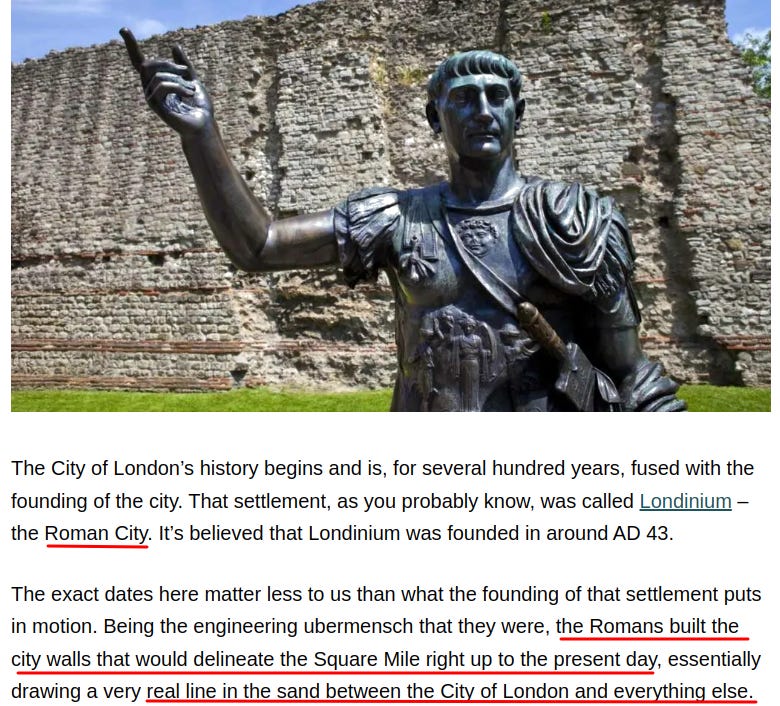
Roman Emperor Claudius invaded Britain in the early 40s AD. Initially, Londinium was used as a military logistics base for the Roman military stationed on the island. However, its location on the Thames allowed for easy travel of ships from all over Europe to come and go from the outpost. It was not long before Londinium proved to be a profitable trading port and a thriving business center. Even 2000 years ago, it was clear this little square mile could be seriously profitable.
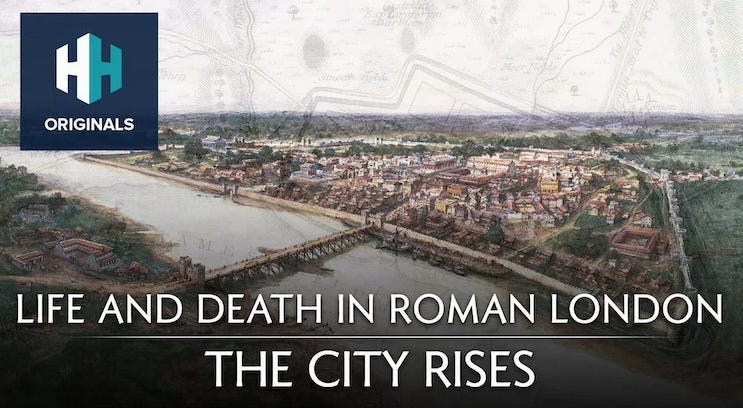
London suffered many ups and downs throughout the next millennia, but it always remained a favourable place for trade. In 1066 AD, William the Conqueror was victorious at the Battle of Hastings. One year later, he recognized the commercial importance of the “square mile” to the broader English kingdom. William provided the City with a charter that guaranteed its freedom.
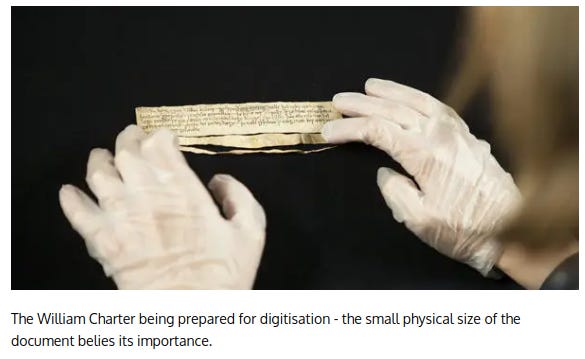
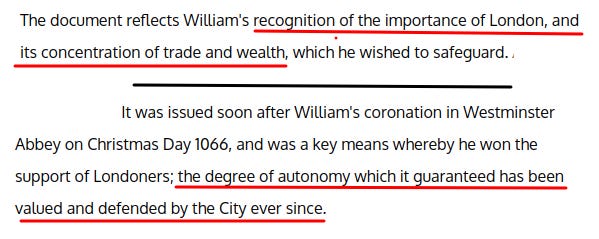
A Free Trade Zone
The Charter that was granted by William the Conqueror was by no means a permanent guarantee of sovereignty to the City. The Charter needed to be renewed periodically:

Why would the British Sovereign continually acquiesce to the residents of a tiny piece of land? The answer is simple; money.
The freedom granted to the City by the British Crown allowed for international free trade to blossom on the banks of the river Thames. Goods could be traded without the burden of taxes, tariffs or duties. Wealthy merchants scrambled to set up a base in the City, and take advantage of “free trading”.
In return, the Royals who were issuing the charter received several benefits. These included direct payments from the City, which expanded the wealth and power of the British Crown. More importantly, the vast amount of wealth and economic activity generated in the City naturally spilled over to the broader kingdom. The kingdom’s subjects benefited from the spending by the City’s wealthy merchants. These subjects included servants, tradesmen, publicans and whores. The “trickle-down effect” provided the British people with jobs that would otherwise not exist if the wealthy merchants were unable to trade freely within the City walls.
Put simply, the deal made between the City of London and the British Crown was mutually beneficial. The City received complete autonomy from the Crown’s jurisdiction, and in turn, the square-mile attracted the wealthiest families in Europe to establish their trading and banking houses. The City became a hive of economic activity.
However, within this “free trade zone” was a dark secret that only the European royal families and the merchants understood. The immense concentration of wealth that was accumulated in the City was always seeking the highest returns from the lowest risk. It started out with the goldsmiths holding gold and silver on behalf of wealthy merchants and royal families, but it soon morphed into a trans-national loan-sharking operation to desperate kings, queens and eventually, other nations. Any State that was desperate for access to credit could be manipulated and controlled by the City of London Corporation, and ultimately would be swallowed up within the walls that the Romans built over a thousand years prior.
The Birth of Debtor’s Money
When the City received its first Charter in 1067, a multitude of sub-companies began setting up shop inside its walls. They were referred to as “Livery Companies”:

OOne of the more powerful Livery Companies within the City were the goldsmiths:

There were many goldsmiths throughout Europe, but the ones within London’s square-mile were special; they could provide unrestricted access to the world’s wealthiest merchants. King Edward I understood the immense potential of “The Worshipful Company of Goldsmiths”:
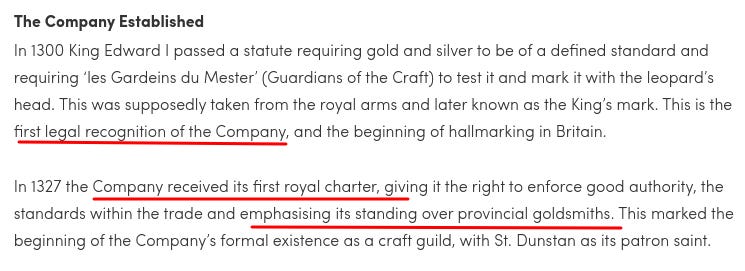
This requirement to carry the King’s mark was another very important union between the City of London and the British Crown. The favored status of the Goldsmiths Company allowed a monopoly to develop within the walls of the autonomous square-mile. Over time, this relationship led to the birth of banknotes, and later, cash money:
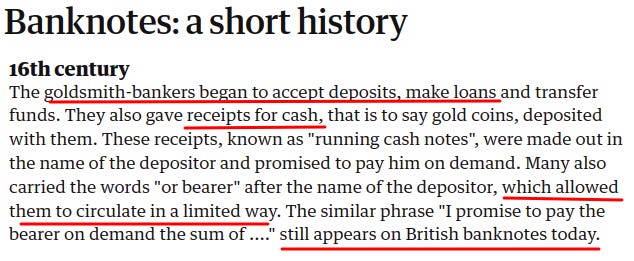
With the City of London Corporation now the preferred dealer in gold coin, they also became the preferred issuer of banknotes. Since the banknote was a “promise to pay on demand”, the goldsmith would need to hold the gold in their vaults in order to fulfill their obligation to deliver on demand. Therefore, the goldsmith’s banknote was essentially a debt obligation. Since the banknotes were being used in the purchase of goods and services, it marked the early days of a debt-based monetary system. The Pandora’s money box had been unleashed.
Desperate Kings Do Desperate Things
During the 1600s, Europe was awash with violence and bloody battles. The Thirty Years War in Central Europe cost up to 8 million lives and a population collapse of over 50% in some German towns, such as Marburg. In addition, there was also the 80 Years War, the War of Mantuan Succession, the Franco-Spanish War, and the Portuguese Restoration War.
This was a period when every kingdom was in a desperate drive to survive. The only kingdom that was ascending during this period was the kingdom of Prussia. Wars cost big money, and the ruling monarchs were desperate to finance their battles in order to remain in power. In the case of Prussia, however, wars were welcomed as a means to gradually acquire strategic power over their rivals.
This was a period of massive upheaval, and many kingdoms found themselves financially destitute, and on the brink of collapse. The English kingdom was no exception. In 1626, King Charles I was faced with an economic crisis, a war with Spain, plague and famine. He was desperate, and he forced the people to lend him cash:

Charles’ “forced loan” had destroyed the merchant’s trust in the Royal Mint. From that moment, they turned their back on the Mint, and instead entrusted their wealth with the goldsmiths of London, primarily the City of London, because they were relatively immune to the king’s orders. The power and control of British money supply was solidifying within the old Roman walls of the square-mile.
Things went from bad to worse for Charles I, and later his son Charles II. It turns out that many of those who were forced to loan Charles I their wealth were seriously pissed off:

King Charles I was eventually arrested, tried for treason, and beheaded. His son, King Charles II, inherited a right-royal mess. Recognizing the pickle that the new King was in, the City of London goldsmiths came to his immediate aid, and he began to borrow money like a drunken fool. The English Crown was soon drowning in debt. These loans became scandalous when the public discovered that much of the money borrowed was used to maintain Charles II many mistresses:
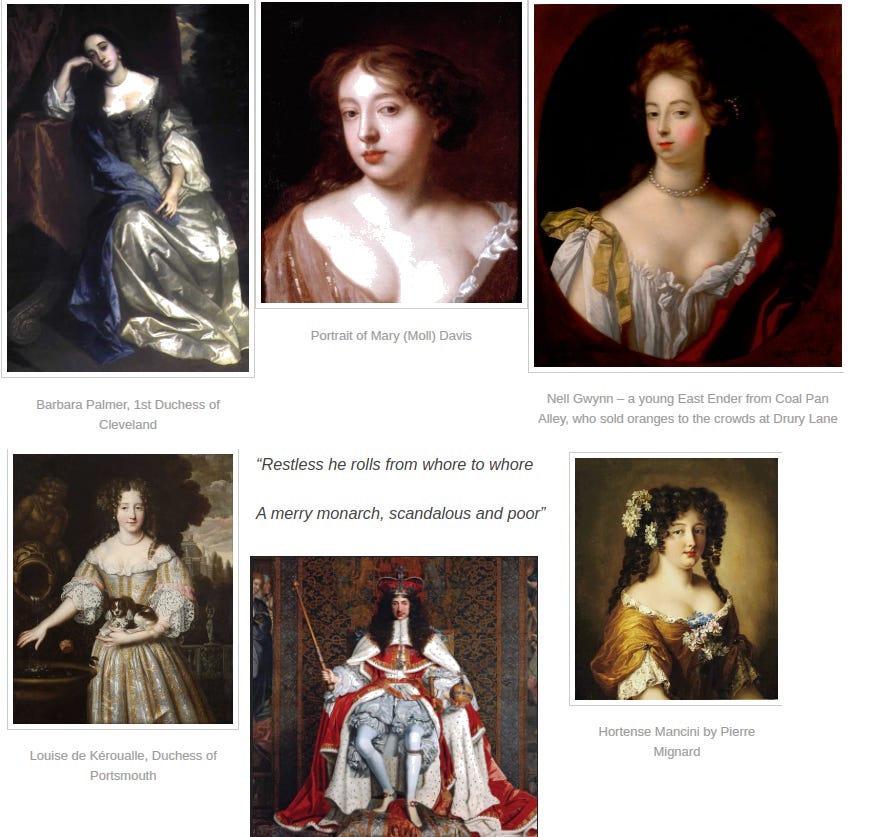
While King Charles II was busy exhausting himself with his harem of bosomy British babes, the kingdom was hurtling toward an inevitable financial crisis.
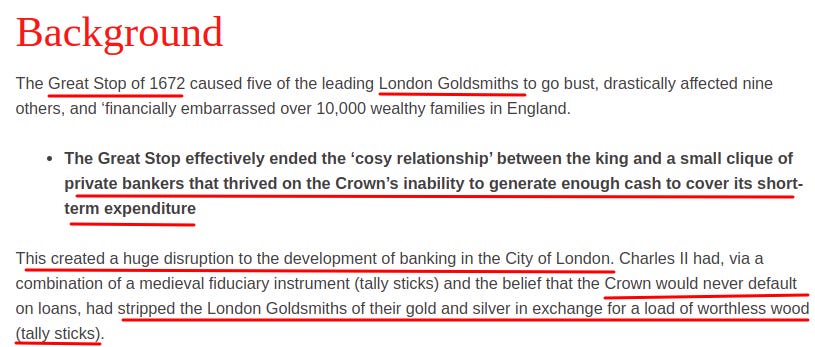
The ‘Great Stop’ was the beginning of the end for the Royal House of Stuart. While the goldsmiths, who were forced to become bankers, took a hit, they were still armed with their wooden tally sticks, and they were determined to be paid back. The City of London bankers stopped lending to Charles, who idiotically believed that the financial crisis could be solved by starting another war with the Dutch. This was, of course, a complete failure. Desperate kings do desperate things:
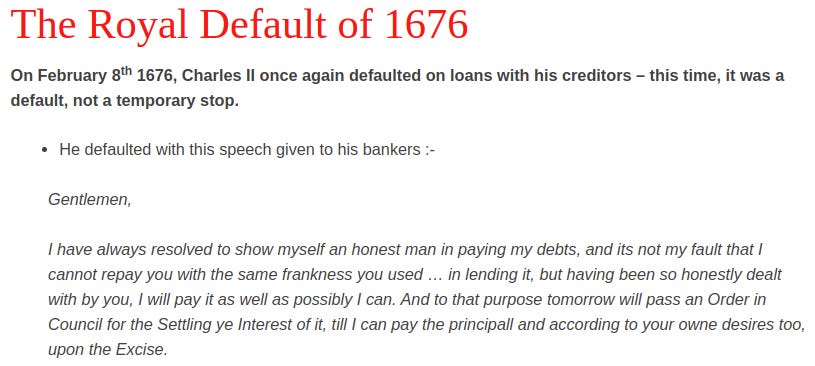
One can only imagine the fury of the City of London goldsmiths at Charles II. He had completely sold out his kingdom, and was about to send the entire national economy into the abyss.
Come hell or high-water, the bankers were going to get paid!!
Glorious Orange Billy
While the wealthy merchants and bankers in the City were trying to figure out how to get their money back from the Crown, the English nobles had decided enough was enough. Everyone was sick of Charles II and his expensive taste in Lady-gold-diggers. Adding salt to the wound, the heir to the Crown was James II, who was a Catholic. This reignited the whole Protestant vs Catholic fiasco. If England descended into another violent civil war, the City of London goldsmiths may never have their loans paid back.
Put simply, they needed a new King. The traders needed a king who would unite the nation peacefully, and find a way to pay back the kingdom’s creditors. Across the English Channel, the merchant traders found their Protestant prince:
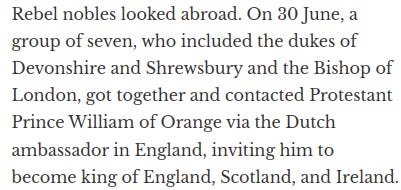
In 1688, William III of Orange marched onto English soil and carried out a bloodless coup. This regime change became known as the “Glorious Revolution”. It was the first successful invasion of England since William the Conqueror in 1066. In a remarkable coincidence, King William of Orange was about to do business with the same ‘free trade zone’ that William the Conqueror engaged with 600 years earlier.
Billy of Orange did not mince his words when he arrived on English soil:

Orange Billy’s Balance Sheet
There was one aspect to William’s invasion that is frequently overlooked. How did this young man manage to raise an army of 20,000+ men and ship them across the channel to invade England? The answer is simple; with lots of money. There was one problem; Orange Billy didn’t have the cash. He needed to borrow money, and he had borrowed lots of it.

It is paradoxical that a Pope would finance a Protestant uprising against a Catholic king. The amount Pope Innocent XI loaned to William is rumored to be approximately 200,000 ducats. Since Pope Innocent was from the immensely powerful Odescalchi banking dynasty, one can only imagine what William of Orange was obliged to do for Pope “Innocent”:
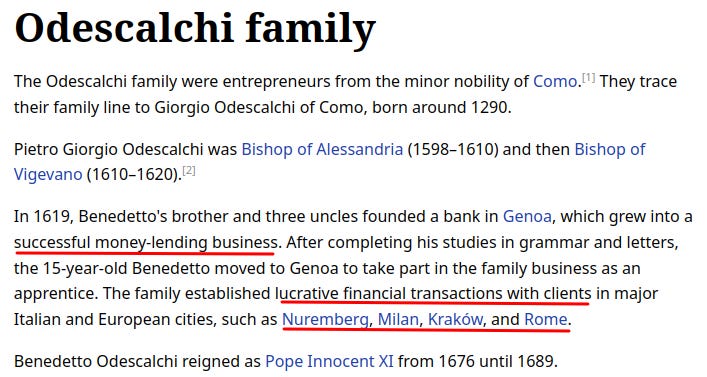
(Note: Nuremberg was run by the Hohenzollern family, known as the Burgraviate of Nuremberg)
The Pope was not the only person who financed William of Orange’s English invasion:
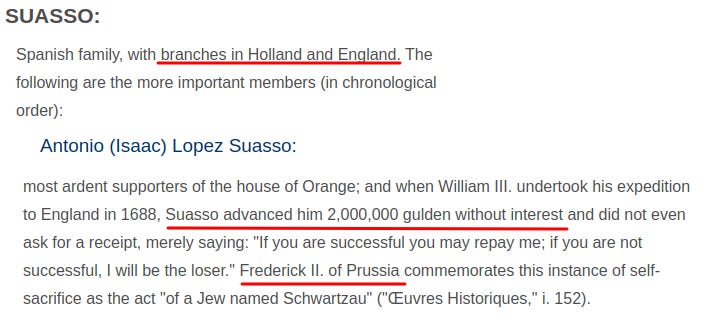
It is significant that Frederick the Great duly noted Suasso’s contribution to William of Orange. What is also significant is that the Suasso family already had significant business dealings in England. The loan to Orange Billy was so huge that it can best be described as an “all in bet”.
With one of the most powerful Vatican banking families and a Jewish/ Dutch banking dynasty waging enormous bets in favor of Orange Billy, what exactly would be their payoffs?
The Glorious Payback
When William of Orange III took the British Crown, many believed it marked the beginning of a glorious new age where the people now had more control:

Many reforms were made under the joint-rule of King William and Queen Mary, but there was an elephant in the royal parlour that simply could not be ignored: What had become of the loans that were advanced to Orange Billy?
What was the state of the Kingdom’s balance sheet?
Considering the atrocious manner in which King Charles I & II managed their finances, could William of Orange ever get another loan from the huge pile of gold sitting in the City of London?
Let’s summarize the financial situation Orange Billy found himself in:
- He had borrowed from Pope Innocent XI, a member of the notorious and scrupulous Roman Odescalchi banking dynasty.
- He had borrowed from the Suasso banking family, who had offices in Holland and London.
- His predecessors had destroyed the credit-worthiness of the kingdom and left many of the City of London goldsmiths (now some of the most powerful private banking houses in the world) with worthless wooden tally sticks. These tally sticks still allowed for a claim, and if Orange Billy did not come to some sort of arrangement with the City of London goldsmiths, he would most-likely be beaten to death by tally sticks.
It was payback time. With power now gradually slipping from the King and towards Parliament, the loans somehow needed to be repaid quickly. Since William could not pay back his creditors with hard currency, something else would need to be offered as a “payment in kind”. This came in the form of the most precious asset in the kingdom; its money supply.
The City and The Bank of England
If we look at who William of Orange was indebted to at this time, it is obvious that he needed to do the bidding of his creditors in order to maintain his throne.
It is hard to imagine that the Odescalchis, the Suassos, and the City of London goldsmiths were simply going to let the new king off the hook.
Every single lender to Orange Billy undoubtedly understood the power of controlling a nation’s money supply. The City’s goldsmiths were masters of the issuance of banknotes, and the Pope and Suasso were from some of the most prominent banking houses in Europe. If there was an opportunity to seize the money supply of the powerful English kingdom, they would jump at the chance. The Bank of England describes the story in their own words:
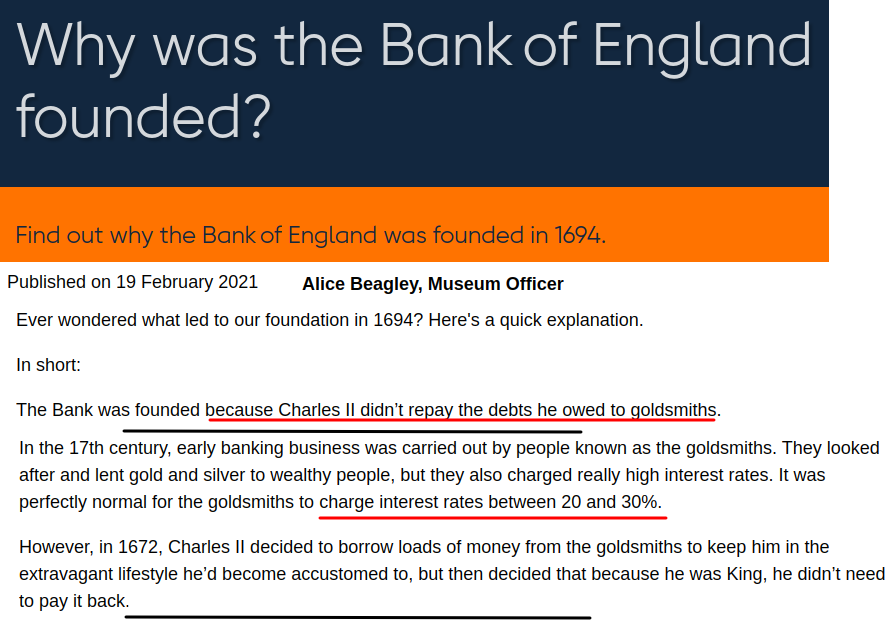
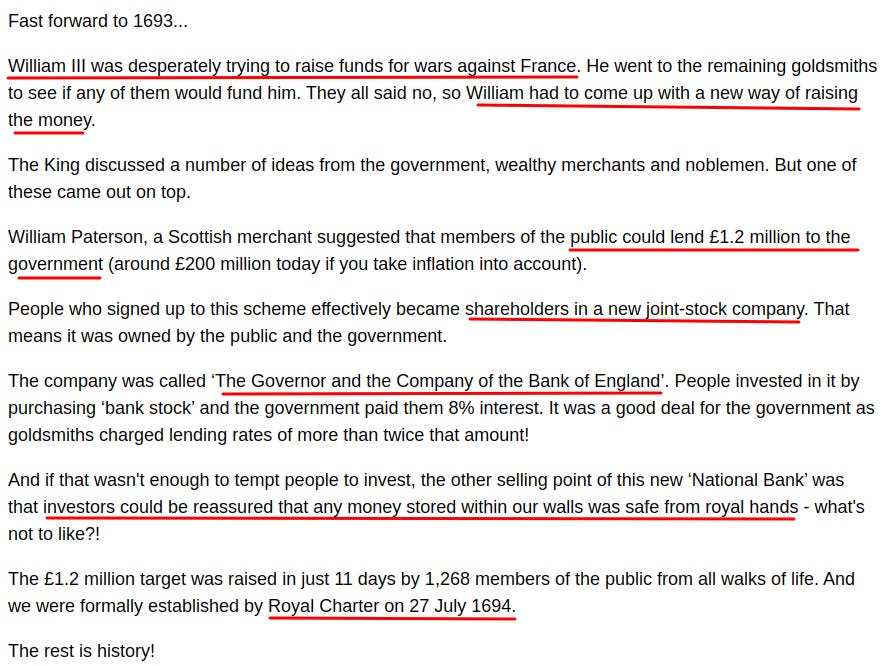
So, the Bank of England openly admits that it was the London goldsmiths, the most prominent of which sat within the protected walls of the City of London Corporation, who were the primary reason behind the formation of the ‘The Governor and the Company of the Bank of England’.
What’s more, those who invested in the ‘National Bank’ were guaranteed that the royals could no longer take their money, as King Charles I did back in 1627.
How could such a guarantee be made?
Firstly, there was a Royal Charter that was signed by William of Orange in 1694. Secondly, and much more importantly, the Bank of England was a company that was located within the City of London, and therefore exempt from the laws of the kingdom.
When the Bank of England stated that “money stored within our walls was safe from royal hands”, they were not joking. Never again could the British Crown seize the gold of the wealthy merchant and banking class that were comfortably residing on the autonomous banks of the river Thames. The old Roman walls that marked the City of London’s boundaries were now impenetrable barriers. It was time to get back to the business of making money.
The Bank of England could now be used as a safe-haven. Since the rest of Britain was gradually moving towards Parliamentary rule and a Constitutional Monarchy, the laws decreed in the kingdom no longer applied to the “freemen” of the City. The only thing the royal family could do now was to look on as the Bank of England filled its vaults with the gold from international bankers and traders, and hope a little was thrown their way, every now and then:

The Suasso Touch
The formation of the Bank of England within the walls of the City of London solidified the power base of the wealthiest merchants and bankers in the world. While the dealings between William of Orange and Pope Innocent XI remain opaque, we are confident that more details will emerge in the future. When the facts are finally revealed, it is quite possible that European history will need to be rewritten and that many uncomfortable truths will need to be reconciled.
One thing we do know is what became of Antonio Isaac Lopez Suasso. After financing William of Orange, the wealth of the Suasso family exploded, as did their connections with the City of London elite. In 1714, Antonio Suasso married the daughter of the Governor of the Bank of England
. With the Suasso fortune intricately tied to the City of London, the family went on to amass an incredible fortune. Whenever they wanted something, they were always granted permission:

The Suasso family are well known for their contributions to the state of Georgia
, but back in the day, they were better known as financial “influencers”. After their incredibly successful loan to Orange Billy, everyone wanted to emulate the Suassos. Wherever they went; whatever they invested in; a gaggle of wealthy Dutchmen followed them. When it was discovered that Suasso married into the family governing the Bank of England, Dutchmen flooded the bank with their cash:

The Dutchies were making a fortune. We should not forget that the Netherlands was ruled by the House of Orange, and were closely related to the House of Hohenzollern. Interest payments were flowing freely out of England, through the Bank of England, and into the kingdom, ruled by the House of Orange.
However, the Dutch investments were not limited to England. The Suassos were broadening their investment activities into America. As a consequence, every Dutchmen with a spare guilder wanted to invest in America:

There was also another member of the Suasso family who had denounced Judaism and took his mother’s name, Diaz de Fonseca.
Today, if we combine the names of Suasso and Fonseca alongside their pre-revolutionary investments into the colony of Georgia, we discover a very shady banking business. It was a business that began with the Mossack Fonseca scandal:

Recall, in our series Havens, Horsheads and Hermann, we explored the fascinating fact that New Zealand was one of the most secretive tax havens in the world. When the “Panama Papers” came to light, it was discovered that there were numerous companies promoting the use of New Zealand as a tax haven. One such company, was Breder Suasso:
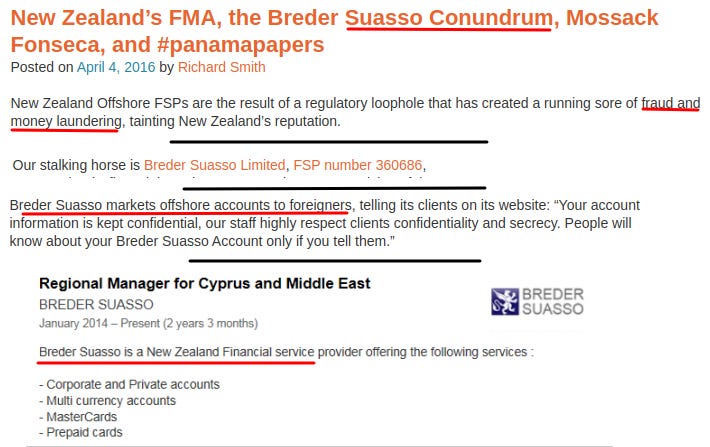

The Suasso-Fonseca name has certainly fallen from grace. It was a name that was synonomous with financing William of Orange’s invasion of England and part of the power-base behind the City of London Corporation; today their names are associated with fraud, money laundering, and dodgy financial services in New Zealand, Cyprus, and the American state of Georgia.
We must also remember that New Zealand Trusts were first established by Sir Francis Renouf, aka “Frank the Bank”. After spending four years in a Nazi POW camp, Frank established a relationship with Hermann Abs. Hermann Abs was originally the Nazi’s #1 commercial banker and served on the board of IG Farben. After the war, the British chose Abs to “reset” the German banking system. He accomplished this with the help of his good friend and former POW, Frank the Bank.
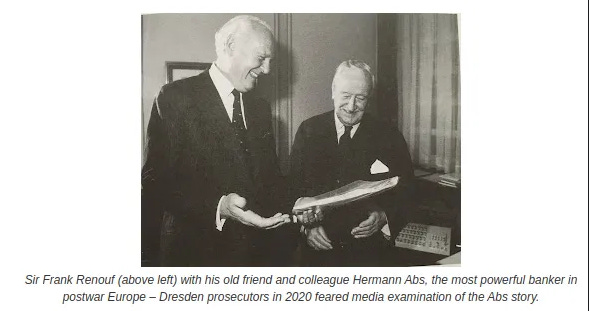
At this point, some may be wondering how this story has turned back to the Nazis. The answer is that it hasn’t. The Nazis were simply a subsidiary of a much bigger organization which originated from the most powerful military force in world history; the power being exerted upon the earth was from the Kingdom of Prussia.
He Who Controls the City……..
As we come to the end of the first part of this ‘1871 Bankster’ series, we have presented the origins of the City of London Corporation, as well as the events that led to the bloodless coup and the installation of William of Orange as King of England. By 1688, the British Crown was in a horrific financial state, and the loan sharks from the Vatican, Holland and the City of London were demanding payback. This came in the form of the Bank of England; a private bank that has controlled the United Kingdom’s money supply ever since.

Most are already familiar with the infamous Rothschild family. However, it can never be stated enough that the founding father of the Rothschild family began his banking career in Germany, at a time when Frederick the Great established Prussia as a world power. During this time, Mayer Amschel was nothing more than an apprentice dealer for the Oppenheimer family.
When Mayer Amschel was picking up nickels as an FX dealer on the streets of Frankfurt, Frederick the Great had already transformed Prussia into a super-state. Frederick also had the most advanced spy network in Europe; particularly in the German principalities that bordered his kingdom. There was nothing in Europe that Frederick the Great’s spy network did not know. To think that the Rothschilds were secretly building an enormous banking machine that could take over the world, right under the nose of the Prussian empire, is quite a stretch.
The truth is that Frederick the Great was building his own banking powerhouse. In The Prussian Origins of the U.S. Federal Reichsbank , we presented the origins of Prussian central banking, which Frederick established in 1765.
https://truthtrench.org/?p=3655

Essentially, it was Frederick the Great who controlled the Prussian money supply. As the father of Enlightened Despotism, Frederick was able to rule his kingdom however he pleased. He monopolized the coin that was to be used for trade, and there was nothing anyone could do about it. Mayer Amschel Rothschild, and his boss Oppenheimer, were effectively “facilitating” trade for Frederick the Great and the military might of Prussia.
When Mayer Amschel Rothschild was pondering the power of controlling a nation’s money, he was most likely referring to the enormous power of Frederick the Great.
Furthermore, Frederick appointed Heinrich Friedrich Karl Reichsfreiherr vom und zum Stein to run the central bank. Heinrich did not like Jews, particularly the Jewish banking sect. Therefore, the Rothschilds, Oppenheimers, Warburgs, and many other Jewish banking families would have to grovel to receive the favor of the Prussian central bank.
However, Frederick the Great was much more pragmatic when it came to Jews:
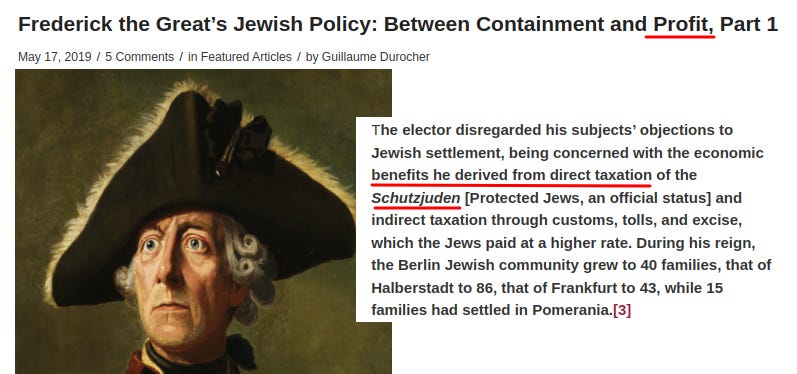
Frederick provided a loophole which afforded certain Jewish families immunity from Prussian persecution.
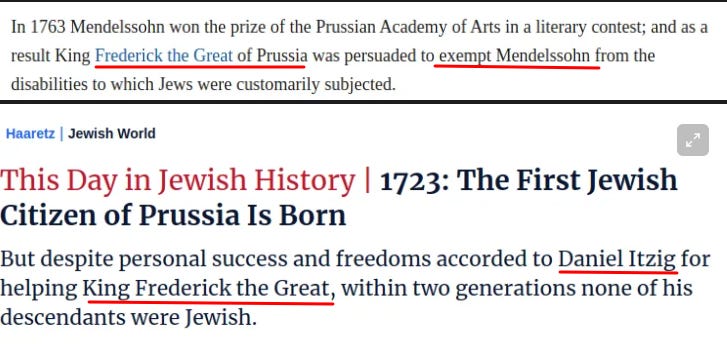
If you could provide Frederick the Great something that served the Prussian empire, you were considered Prussian. The exemptions provided to Daniel Itzig and Moses Mendelssohn laid the foundations for one of the most powerful banking dynasties in history. However, that power was afforded to them by Frederick the Great. In return, Frederick received access to, and intelligence from, the entire Jewish banking elite. This intelligence included the secrets of the City of London and banking dynasties, such as the Suassos.
Hanseatic Power
In Evolution of Slavery – Part I we presented the origin and evolution of the Hanseatic League; perhaps the most powerful trading block in world history:
https://truthtrench.org/?p=3687
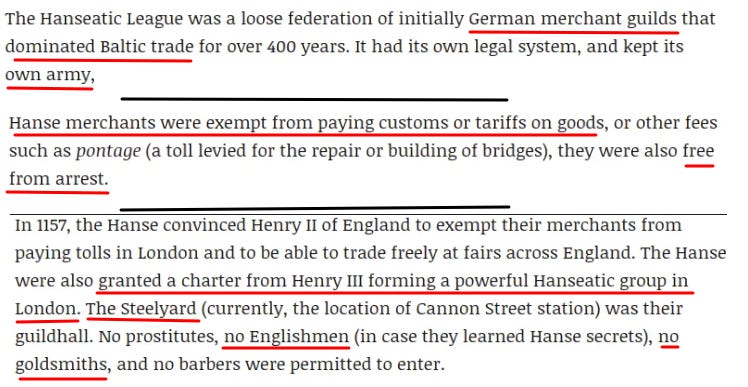
This is a crucial part of history that is critical in understanding the power within the City of London. The City of London and its Livery Companies were exempt from royal interference. The Hanseatic League effectively received a similar charter. This benefit was not just contained within the tiny square-mile, but across the whole of England. Furthermore, the Hanse not only received this freedom in England, but throughout the entire Holy Roman Empire, and beyond.
Any King who decided to “fuck around” with the Hanse would very quickly “find out”. The League had a monopoly on almost all Baltic and North Sea trade. Any nation-state trying to stand up to them would be cut off from global trade, sent into an economic depression, and eventually attacked by the Hanse’s private military.
Every kingdom who understood basic economics realized it was a death sentence to deny the Hanseatic League unrestricted access to their markets. England was no exception. The ‘free-trade’ charter was granted to them by the king, and the Hanse set up their trading base in ‘The Steelyard’; located on the banks of the river Thames, in the City of London:
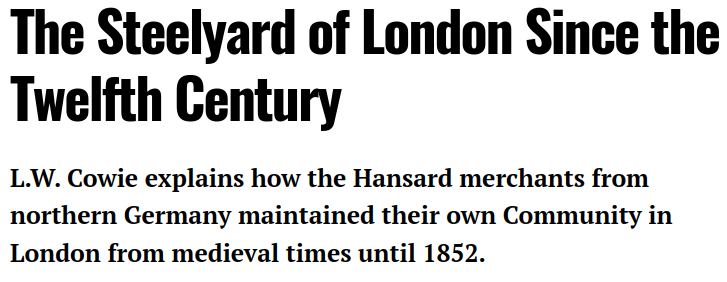
Our Evolution of Slavery article continues to explain how German trading houses became the dominant players in England because they had access to a much larger international trading network.
The Ruckers, Rothschilds, Barings, Schroders, Warburgs, and many other families all set up their financial bases within the City of London. There were also many Jewish bankers throughout Europe who flocked to the City to establish themselves. The most powerful Jewish banking family of the time were the Mendelssohns, and they were tightly controlled by the kingdom of Prussia.
Regardless, there was also a huge migration of German merchants into London. The City was effectively taken over:
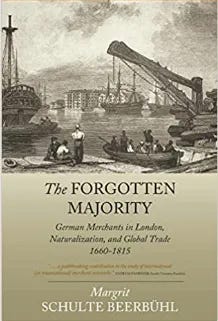

The City of London became the center of world trade, banking, insurance, finance and capital markets. The Bank of England sat comfortably within the walls of the City and ensured the issuance of banknotes benefited the City’s “freemen” and supported their interests in global capital and trade. Almost everything that was traded in the Western world passed through the financial tollgates of the world’s largest banking and trading houses, which were almost-exclusively located in the City.
The Rothschild’s boast controlling the Bank of England and the issuance of currency is certainly an interesting event in history. However, it would be a nonsensical and baseless claim unless the Bank of England was protected by the autonomy first granted to the City of London Corporation by William the Conqueror in 1067.
Controlling the nation’s money supply is one thing; controlling the City that protects the corporation controlling the nation’s money supply, is quite another.
By the 18th Century, he who controlled the City, controlled the world. Those who understood this principle gradually transferred their wealth, power and families to London. The German merchants, who were now some of the most infamous banking dynasties in history, dominated this migration to the City.
Nothing was far from the reach of Prussian influence, the desires of Frederick the Great, or the eyes of his powerful spy network. By 1871, every noble house in Germany had pledged their allegiance to the king of Prussia. The Hohenzollerns were proclaimed the Kaiser of the German Reich, kings of Prussia, and the princes of Orange.
Thinking Logically
This is a story of how wealth and power was systematically stripped from kings, sovereign nations and from ‘We the People’. What we have presented so far is nothing mysterious or conspiratorial; it simply outlines facts throughout history that illustrate how it was accomplished.
Londinium established itself as an attractive place to amass wealth as far back as Roman times. Kings like William the Conqueror understood the importance of doing business with wealthy, international merchants. From the moment he granted the City of London its Royal Charter in 1067, the symbiotic relationship between the British Crown and the City was cemented.
The art of war and statehood was left to the head of state, while the art of making money was in the hands of the merchants. Eventually, the wealth of the merchants became so great that they would, from time to time, lend out their huge stockpiles of gold to European nobility and kings. Eventually, there would come a time when the aristocracy could not pay their dues. When this happened, there was always something that the money-lenders could take in return; frequently this was a noble title, and other times it was something even more special, like a central bank.
Recall in An Ode to the Prussian Pickle – Part I in the early years of the House of Hohenzollern, they were providing the Holy Roman Emperor, Sigismund, with enormous loans for his military campaigns in Translyvania. When he could not repay the money, the Hohenzollerns secured the Margraviate of Brandenburg as payment, a title which gradually turned them into Kaisers of the Reich.
https://truthtrench.org/?p=3701
The same playbook was adopted between the City of London and the British royals. Wars and an expensive taste in loose women tend to cost a lot of money. The king would borrow endlessly from the City’s goldsmiths, and in return would provide them with a promise to pay the loan back using a wooden tally-stick as the contract. When the kingdom could not fulfill their promise, it was payback time. This time, however, the money-lenders did not want a noble title. They wanted a regime change and installed William of Orange as king. More importantly, they wanted to have guaranteed and complete control of the kingdom’s issuance of banknotes.
The City of London was now an autonomous wealth-haven sitting right in the middle of London. However, the Bank of England was not the only trophy sitting within the City walls. To see the real power within the City of London, we must recall the Hanseatic League’s immense power and wealth derived from controlling the Baltic and North Sea trade:
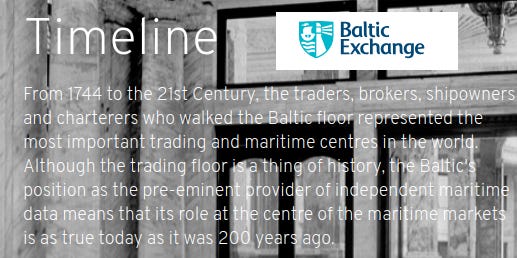
The Bank of England, Baltic Exchange, London Stock Exchange, London Commodities Exchange, London Metal Exchange, London Bullion Exchange, Lloyds of London and even the media monopolies on Fleet Street, were all located within the City’s walls. Almost all world trade was now monitored, financed and exchanged within the City.
Once William of Orange took the Crown and the great German-merchant migration was underway, almost every aspect of British commerce and royalty was in German hands. The people were given a Parliament which could govern and issue new laws, but this power meant nothing if the issuance of the nation’s money supply was not in their jurisdiction. As the Rothschilds’ continually quipped, “I care not who writes the laws”…
In 1871, King Wilhelm I, was crowned the Kaiser of the German Reich, king of Prussia, and prince of Orange. A united Germany pledged their allegiance to Wilhelm I. When we look at the level of German infiltration that took place in the United Kingdom and the City over the centuries, we must ask ourselves who is really in charge.
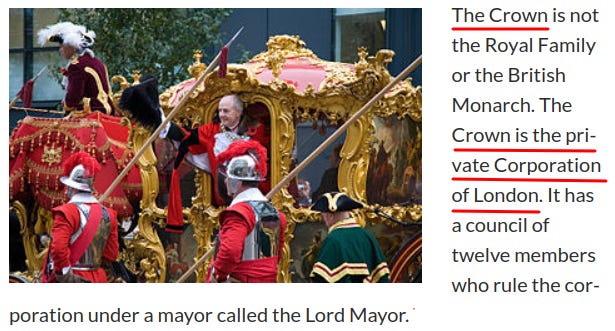
At this stage, some might be asking what any of this has to do with the interviews with Dr. Jan Halper-Hayes, and in particular her reference to 1871.
We are glad you asked.
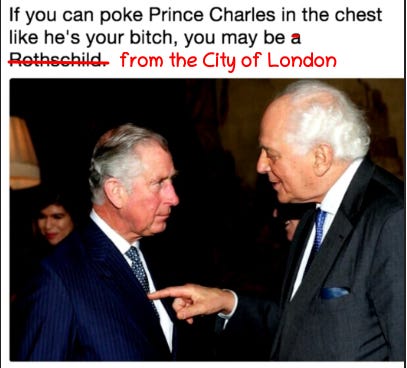
To be continued………………..
https://www.cityoflondon.gov.uk/about-us/about-the-city-of-london-corporation
https://www.cityoflondon.gov.uk/about-us/about-the-city-of-london-corporation/our-role-in-london
ibid
ibid
https://www.cityoflondon.gov.uk/about-us/law-historic-governance/livery-companies
https://www.thegoldsmiths.co.uk/company/history/history-of-the-company/
ibid
https://www.theguardian.com/business/2013/sep/10/banknotes-history
https://www.liquisearch.com/history_of_money/goldsmith_bankers
http://bcw-project.org/church-and-state/the-kings-peace/forced-loans
https://www.english-heritage.org.uk/learn/histories/the-english-civil-wars-history-and-stories/
ibid
ibid
https://www.worldhistory.org/Glorious_Revolution/
ibid
https://www.irishtimes.com/news/new-book-claims-pope-bankrolled-king-billy-1.921042
https://www.wikiwand.com/en/Erba-Odescalchi
https://www.jewishencyclopedia.com/articles/14093-suasso
https://www.nam.ac.uk/explore/army-and-glorious-revolution
https://www.bankofengland.co.uk/museum/online-collections/blog/why-was-the-bank-of-england-founded
https://www.jewishencyclopedia.com/articles/14093-suasso
ibid
ibid
https://prussiagate.substack.com/p/havens-horse-heads-and-hermann-part-ba6
https://de.zxc.wiki/wiki/K%C3%B6nigliche_Hauptbank
https://prussiagate.substack.com/p/havens-horse-heads-and-hermann-part-ba6
https://www.historytoday.com/archive/steelyard-london-twelfth-century
https://www.balticexchange.com/en/who-we-are/history.html
